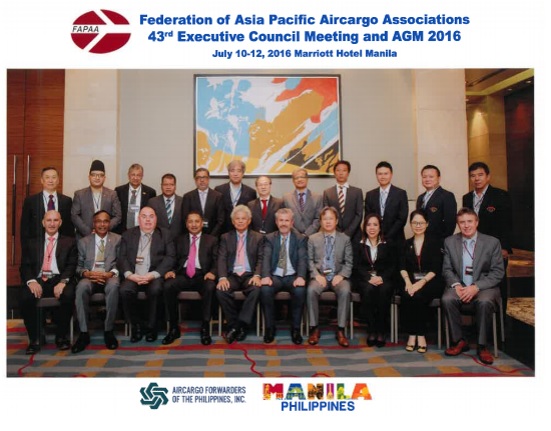
On a mission to find out more about other air cargo associations in Asia, the Air Cargo Association of Korea (ACAK), with the support of their government, went on an expedition to Singapore to meet with the Singapore Air-cargo Agents Association (SAAA). It was April 1985 when this happened.
During the meeting, both sides exchanged ideas and discovered that they were facing the same types of issues.
One was that the relationship between the airlines and air cargo agents were cordial but very much one sided. The other, IATA’s conditions were rigid, making them very one-sided in the eyes of the agents. Therefore, there could be no dialogues except for the agents to comply with what was coming to them.
However, local conditions differed! Most problems had to be resolved locally and there was no form of comparison from one country to another in the region.
That led the two associations to feel that Asia as a region was not represented at all. So, it was concluded that information sharing within the region would play a vital role. Thus, leading the two associations to call on other countries to form a regional association, one where they would have only associations as members in the Asia Pacific region.
The target date for a formation meeting was set for November 1985 so as to give SAAA time to draft the constitution, with legal help if necessary.
During that space of about one and the half months, SAAA connected with Thailand, Malaysia, and the Philippines. While ACAK was in charge of connecting with Hong Kong, Taiwan and Japan. The other associations welcomed the idea and were both eager and excited to meet in November.
Seoul, it was!
As planned, the “Formation Meeting” took place in November of 1985. Nine recognised and National Associations from 8 countries attended, Malaysia having sent representation for two associations across. It was the most memorable event in the history of FAPAA and many of the veterans termed it as a “good omen”.
As soon as the FAPAA pro-tem Chairman, Mr S D Hong, also Chairman of ACAK declared the meeting opened, it started snowing! This meant the meeting room of the Hyatt Hotel, with its wall to wall, ceiling high windows was the best setting possible. Drapes were initially half-way drawn, but this soon changed as many of the delegates who had never seen snow before, rushed to the windows to enjoy the snowfall. The meeting was disrupted for probably 10 to 15 minutes to allow delegates more time at the window. Even the Korean delegates were excited and jumping for joy, exclaiming that it was too early to see snow.
Incidentally, ACAK changed its name to the Korea International Freight Forwarders Association (KIFFA) which included the agents involved with sea freight.
Likewise, during the existence of FAPAA, many other associations have also changed their names to include the sea freight forwarders. It just makes sense!
Setting Intentions
Led by SAAA, who made the presentations on the intentions, motives and expectations from this group, all the associations welcomed the idea and pledged their support. Several names were suggested and the conclusion was unanimous for the “Federation of Asia-Pacific Aircargo Associations”, FAPAA. It was also concluded that FAPAA would then try to reach to every country in the Asia-Pacific region. Terms and conditions were discussed and every association made a considerable contribution. SAAA was then nominated to take care of the constitutions while it was agreed the registration would be done in Hong Kong.
Another intention was to connect with IATA having regular dialogues to discuss issues related to the region. Leading to IATA becoming a regular guest at all FAPAA meetings – which incidentally, had been going on annually and by rotation, hosted in the various member’s countries.
Although not a rule, it was also the general consensus that the FAPAA chairmanship would rotate. This would give different member associations the opportunity to take the lead at one time or another.
Educating the industry has always been FAPAA’s biggest concentration. With the assistance of IATA, most of the member countries now host training centres, especially to comply with IATA’s requirements. FAPAA had several activities in relation to realising this dream and were kept quite busy in the early years.
Campaigning for new members
Today, FAPAA can boast to having a total of 18 members in the Asia Pacific region, and uniquely, all of them being associations.
FAPAA communicated with UNESCAP in its attempt to get grants and fundings for the undeveloped countries in the region. However, because the FAPAA membership also comprised of developed countries, FAPAA did not qualify for such grants.
Through its Malaysian members, FAPAA continued to have regular dialogues with UNESCAP, in order to qualify for the grants. The solution was FAPAA had to ask its ASEAN members to form another organisation.
The Birth of AFFA
In December 1991, led by FAPAA’s Malaysian member, a new organisation was formed and it was named the Asean Federation of Forwarders Associations or AFFA – with its first meeting taking place in Penang.
Grants from UNESCAP were then received by AFFA – which has since grown in strength with an expanding membership.
From day one, FAPAA’s aims and intentions were clearly spelt out. Information-sharing is still very much the name of the game.
Although FAPAA is not a member of FIATA, FAPAA does encourage its members to join the FIATA membership as well as attend its meetings.
The success of FAPAA is the result of the co-operation of its members.








